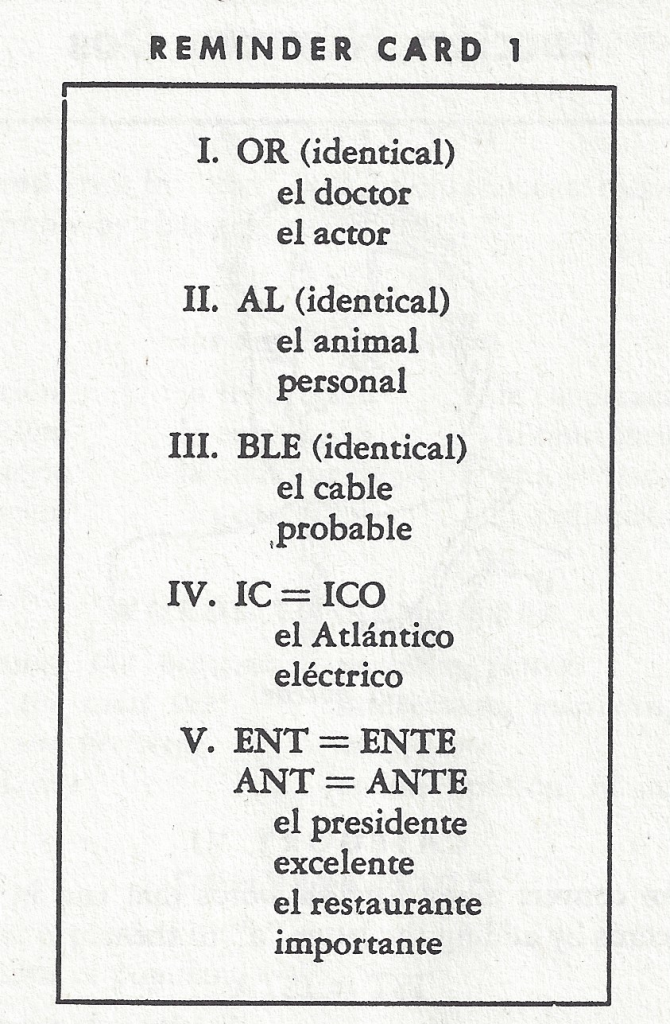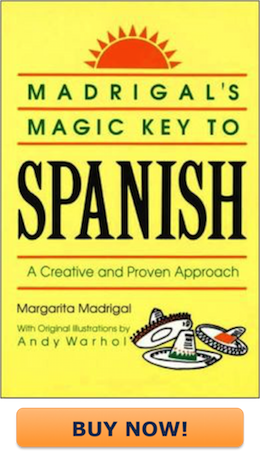The Best Book for Learning Spanish Vocabulary:
Madrigal’s Magic Key to Spanish
First Publish date: 1951
Pages: 496
Author: Margarita Madrigal
Over 60 years after it’s first publication, Madrigal’s Magic Key to Spanish by Margarita Madrigal still may be the best book for learning Spanish vocabulary ever published. The premise of Madrigal’s book is that if you know English then you already know a large amount of Spanish as well.
The Method
The first line of the book offers insight into the author’s teaching method on learning Spanish: “At this moment you know several thousand Spanish words even if you have never seen or heard a Spanish word before.” She continues along offering up the following list of Spanish words: popular, capital, animal, hotel, radio, conductor, probable, cable, actor, ideal, flexible and central.
Following quickly after the list of Spanish words is the question “Can you recognize any of these words?”: Atlántico, Pacífico, dramático, atractivo, restaurante, importante, presidente, medicina, dentista, artista, confusión, invitación.
With these first words, it becomes clear that Spanish vocabulary is closely tied to English and the author plans to use this as a springboard to fluency in Spanish.
Madrigal winds down the preface by promising that her book will teach you to Speak, Read, Write and Think in Spanish. At first, this promise seems too broad and even not credible. However, as you work through the lessons and exercises, you understand how this is true.
Sample Lesson
In the first lesson of the book, Madrigal immediately launches into teaching you how to accelerate your vocabulary acquisition. Most books focus on rote learning of vocabulary and quickly bore you, put you to sleep, or fail to teach you. Madrigal’s method is different. Instead, she teaches you how to build and expand your own vocabulary by defining categories of words that can easily be converted from English to Spanish.
For example, words that end in “ic” in English simply require adding an “o” to arrive at their Spanish equivalent. Even easier, a second category shares that many English words ending “ble” are the same exact word in Spanish.
With only five guidelines in the first chapter, you walk away with over 450 different words that you already know, easily recognize or can quickly convert to Spanish. With 45 lessons in the entire book, it is easy to see how thousands of words will be taught and why this may be the best book for learning Spanish vocabulary you will ever run across.
 Here’s a sample of the short-cuts the book shares:
Here’s a sample of the short-cuts the book shares:
Verbs
Another difference is that verb conjugations are taught differently from many other Spanish textbooks. Most books teach how one verb is conjugated for I, you, he/she, we, they. Madrigal’s book focuses on teaching one conjugation, for example I, across hundreds of verbs. I find this method to be better. While there is repetition of the conjugation, at the same time you are learning numerous vocabulary words. This seems to be much more useful for the beginner than learning one verb and 5 conjugations.
Tied in with the teaching of verbs, is the teaching of questions. So, for example, just by teaching “Did you…?” and “Did Maria…”, then including the verb, hundreds of questions may be created. This is another great method for rapid development of vocabulary. A sample is the verb conjugation “comió” which when combined with the two questions, allows you to ask “Did you eat” and “Did Maria eat”. It seems simple however just by learning one verb conjugation (really two conjugations, he/she and Usted, both with the same ending) across verbs and combining them with these two questions, a simple conversation can be held in Spanish.
This simple approach is continued throughout the book.
Finally, practice tests are included every ten lessons or so, to review your advancement. These may be used time and time again to continually verify you are advancing while retaining previous lessons.
This book will be one of the best investments in your Spanish learning you will ever make.
Positive Points
• You will learn lots and lots and lots of vocabulary
• The vocabulary ties between English and Spanish really are amazing. And the book lays out these ties with simple rules and guidelines, making them easy to remember and apply.
• The book also tackles verb conjugation and some basic grammar.
• Practice exercises abound.
Negative Points
• It is just a book so the speaking portion of the Spanish learning is mildly useful at best. To be fair, this applies to any book.
• This is a minor pet peeve, but proper names are translated throughout the book. Elena becomes Helen and Carlos, Charles. They should just be left alone.
• Just to continue with pet peeves, I don’t like a book with a poor index. Madrigal’s Magic Key to Spanish falls into that category. For a 500 page book to have a 4-page index, someone got lazy at the end.
I know these criticisms are minor. Overall, this is an amazing book that everyone should use for self-study. Even 60 years later.
What is the best book for learning Spanish vocabulary that you have ever run across?
Check out these other articles on Spanish Books.
